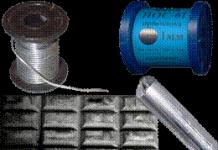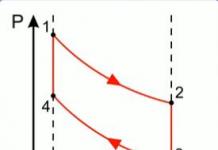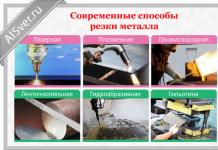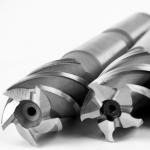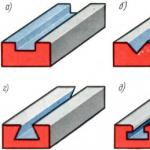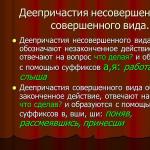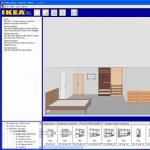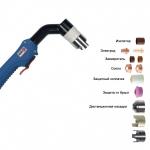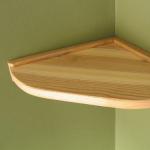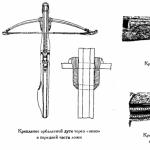Soldering- the process of obtaining an inseparable connection of various metals using a molten intermediate metal melting at a lower temperature than the joined metals.
Soldering is widely used in various industries. In the electrical industry and instrument making, soldering is in some cases the only possible method of joining parts.
TO benefits rations include:
- slight heating of the connected parts (preservation of the structure and mechanical properties of metals);
– the purity of the compound, which in most cases does not require further processing;
– preservation of the sizes and shapes of parts;
– sufficiently high connection accuracy;
Modern methods allow brazing carbon, alloy and stainless steels, non-ferrous metals and their alloys.
Solder- an intermediate alloy or metal used in soldering.

Solders should have properties:
- have a melting point lower than the melting point of the soldered metals;
– in the molten state, interacting with the protective medium, flux or in vacuum, it wets the brazed material well and spreads easily over its surface;
– provide sufficiently high characteristics (strength, ductility and tightness) of the soldered joint;
- do not form a corrosion-unstable pair with brazed materials;
– have a coefficient of thermal expansion close to the coefficient of the brazed material;
Tinning- surface coating with solder. It is applied to protection of the prepared bolted connections or the soldering of a surface.
2. Solders and fluxes, their varieties and composition.
Solders are:
– fusible (soft), melting point up to 500°С;
- refractory (solid), melting point above 500°C.
Low-melting solders are used in all industries and in everyday life.
Compound: tin-lead alloy (POS grade), tin content from 18% -POS18 to 90% -POS90.
The specific conductivity of these solders is 9÷13% of the specific conductivity of copper. There are also soft solders with additives of aluminum, silver. Even softer solders, which include bismuth and cadmium.
For soldering copper conductors, POS18 solder is used, and for thin copper conductors, softer solders (POS40; POS50; POS61) are used. Low-melting solders are produced in the form of ingots, wire, cast rods, turf, foil, tubes with internal packing with rosin, with a diameter of 2 to 5 mm, as well as in the form of powders and pastes from powder with flux.
Hard solders- copper-zinc (PMC) and silver (PSr).
Copper-zinc solders (PMTs36; PMTs48, etc.) and copper-phosphorus solders (PFOTS 7; 3; 2, etc.) are brittle and not resistant to vibrations, shock loads, the electrical resistance of the seams is very small.
Silver-copper solders (copper 40; silver 25; zinc 35) are characterized by low electrical resistivity. They are widely used for soldering current-carrying parts, for ferrous and non-ferrous metals. In this case, mechanically strong and corrosion-resistant seams are formed.
Solder based on aluminum with the addition of copper, cadmium, tin are characterized by increased mechanical strength and resistance to atmospheric corrosion.
For soldering aluminum cores of wires, zinc-tin solder grade A (40% tin), zinc-tin TsO12 (12% tin and 88% zinc) solder is used.
Flux- the second important substance when soldering. Cleans the surfaces of soldered metals from oxides and impurities. Protects the soldered metals from oxidation during the soldering process, reduces the surface tension of the solder, improves the spreading of the solder and the wettability of soldered surfaces.




Fluxes are:
- solid powdery substances (borax, boric acid, rosin);
- liquids (an aqueous solution of zinc chloride, an alcohol solution of rosin);
- pastes (rarely used).
According to the effect on the metal being soldered, fluxes are divided into groups:
– Active (acidic) fluxes- hydrochloric acids, chloride and fluorine compounds of metals, etc.
After soldering with this flux, the processing site is thoroughly washed. When installing electrical and radio devices, the use of active fluxes is unacceptable.
– Acid free fluxes- rosin and fluxes prepared on its basis with the addition of alcohol, glycerin and other inactive substances.
– Activated fluxes- rosin with the addition of activators (small amounts of hydrochloric acid or phosphoric acid ammonia).
– Anti-corrosion fluxes- based on phosphoric acid with the addition of organic compounds and solvents. Residues of these fluxes do not cause corrosion.
3. The main tool for soldering is a soldering iron.

Clean the sting periodically with a file.
Soldering iron designs are:
– with internal heating;
– micro soldering irons (soldering microchips, film circuits, etc.) power 4 and 6 W;


– with automatic stabilization of tip temperature. It consists of two electrically interconnected nodes: a temperature stabilization unit and the soldering iron itself.

4. Solder termination of wires and cables.
Copper conductors are soldered with soft solders. Single and stranded conductors with a cross section of 1.5 ÷ 10 mm² are soldered with a soldered twist.
The insulation from the end of the core is removed over a length of 15 mm, the core is cleaned with sandpaper, the cores are twisted and soldered with a soldering iron or in a bath of molten solder. The termination of wires with a cross section of 1 ÷ 2.5 mm² is performed in the form of a ring followed by a half. To do this, remove the insulation from the end of the core at a length of 30 ÷ 35 mm.
They clean it, bend the core in the form of a ring with round-nose pliers, solder it and, after cooling, insulate it with a polyvinyl chloride (PVC) tube or electrical tape to the ring.
Aluminum wires are soldered with solder grades A or TsO12 (or TsA15). Solder with a propanobutane or gasoline blowtorch. Single-wire conductors with a cross section of 2.5 ÷ 10 mm² are soldered with a soldering iron using a double twist:
 |
|||
 |
|||
After cooling, the soldering points are insulated with electrical tape by wrapping the soldered cores with the approach to the wire insulation.
Copper and aluminum are soldered in the same way.
Aluminum stranded conductors with a cross section of 16÷150mm² remove insulation over a length of 50÷70mm. Before removing the paper insulation, a thread bandage is applied at the place of its cut. Then they are loosened with pliers by twisting the wires of the strands, and the impregnating composition is removed with gasoline. Rubber insulated conductors This operation is not required. Sector-shaped cores are rounded with universal pliers. The end of the core, cleared of insulation, is cut in steps. Several turns of corded asbestos are wound around the edge of the insulation to prevent melting of the insulation during soldering. .
The termination of aluminum conductors is carried out with tips. The size of the tip will be one step higher in cross section. If the core is 50mm², take a tip, 70mm² to penetrate the solder into the gap between the tip and the core.
The connection of single-wire and multi-wire conductors with a cross section of 16 ÷ 40 mm² is performed by pouring pre-molten solder. .
Single-wire conductors with a cross section of 16 ÷ 50 mm² are soldered in copper sleeves. Solders TsO12 or TsA15 are used. The solder is heated to a temperature of 600°C. Before soldering, the conductors are cut in steps (stranded) or the ends are cut with a hacksaw at an angle of 55 ° to the horizontal.
TB during soldering and tinning.
Working with molten solders is associated with a risk of burns. Therefore, you should beware:
- getting molten solder on unprotected hands;
- getting on clothes;
- hits, on an inclined surface, along which the solder can roll to indefinite places;
– falling drops of solder from a height to avoid splashing.
Conditions for the use of various grades of flux:
- a well-ventilated area;
- suction of harmful fumes from each workplace during mass work.
To reduce the danger of soldering irons, you must:
- do not allow the soldering iron to overheat;
- use a soldering iron with temperature control (less current while the soldering iron is on the stand, more directly during soldering);
- prevent the possibility of crushing, rubbing or touching the heated body (sting) of the current-carrying cord of the soldering iron.
6.Electric welding
Electric welding- the process of obtaining a permanent connection of solid metals, carried out by melting the metal and subsequent cooling.

It is applied to welding practically any metals and alloys, at any form of the welded details.
Varieties:
1. arcless, by contact heating;
2. arc, carbon electrode on a negative current and arc manual;
3. automatic, consumable and non-consumable electrodes.
Example: TSK-500 secondary voltage is 60÷65V, arc voltage is approximately 20÷30V, welding current regulation limits are 165÷650А. To use the setting of the welding current, a scale with divisions is located on the top cover of the casing. More precisely, the current strength is determined by the ammeter.

Oscillator converts power frequency and low voltage current into high frequency current (250÷300kHz) and high voltage (2.5÷6kV), connects to a transformer to provide welding arc excitation.
Soldering:
1. the area of electrical contact of the parts to be joined, formed by solder, should be possible;
2. possible mechanical loads on the solder joint should be carried by the structural elements of the parts to be joined, and not by the solder.
Topic 3: Connecting and terminating wires.
Plan:
1. The requirement for contact connections.
2. Materials, tools and devices used.
3. Methods for terminating wires by crimping and soldering.
4. Detachable connections.
5. Marriage and preventive measures.
1. Requirements for contact connections. Detachable and non-detachable connections. Application.
The electrical contact formed when connecting the wires to the terminals or to each other must meet the following requirements:
– reliability under all operating conditions for which the device is intended;
– be stable and not cause additional heating of the contact connection due to contact losses;
– type, size, simple arrangement and type requirement.
Contact connections, depending on the purpose, can be detachable and one-piece.
Plug contacts are used:
- in case of private disassembly of the contact connection (clamps of electric machines, clamps of switchgear, etc.);
- when making a contact connection at the installation site of the device and the absence of amenities, for making a permanent connection (wall switches, sockets, etc.);
Permanent connections are used:
- if there is no need to disassemble the contact during operation (connecting wires, cables, permanent branching of wires, connecting several coils, radio circuits, etc.);
- in the absence of access to inspect the state of the contact connection, etc.

2. Materials, tools and devices used for connecting, branching and looping wires.
Various tools and devices are used for productivity.
For decoupling individual copper and aluminum conductors as well as armored and unarmored cables (example: sector shears).
Kletnevka- for applying wire bandages, for fixing the cable armor (it looks like a wooden bar with a handle and a half-clip).
When the cage rotates around the cable, the binding wire, passing through its curved channel, is stretched.

Armored cutter– for cutting the steel armor of the cable.
Blades with adjustable cutting depth - for circular and spiral, longitudinal cuts of lead and aluminum cable sheaths.
Cuts in any direction on plastic shells are made using a fitter's knife with an internal cutting edge.
Thermopliers- for removing plastic insulation from current-carrying wires. The jaws of the pliers are equipped with a set of annular and longitudinal knives for wires with conductors with a cross section of 1.5÷6mm². Closed heaters powered by a 36 V source are installed on the sponges.
Universal pliers- for removing rubber, plastic and cotton insulation of wires and cables with a cross section of 0.75 ÷ 1.5 mm². They are equipped with knives for biting the veins.
With step cutting, each step is cut and fixed with a bandage. The width of the bandage depends on the diameter of the steps and is usually 8÷12mm. Depending on the required strength, bandages are made of galvanized knitting wire with a diameter of up to 1 mm,
twisted twine with a diameter of 1 mm or a harsh thread. If necessary, bandages are strengthened with BF glue.
To terminate the insulation of the cores of cut wires and apply marking, marking sleeves, pieces of PVC pipes, insulating marking end caps, whole and type-setting, as well as type-setting end caps from adhesive marking tape are used.
 |
Welding is also used.
3. Methods for terminating wires by crimping, soldering and electric welding .
Crimping is performed with manual tongs, mechanical or hydraulic press using replaceable punches and dies (depending on the section).
Punches and dies are selected according to the diameter of the tubular part of the tip or connecting sleeve.
Distinguish 2 crimping methods:
- local indentation;
- continuous compression.
The first method is the most common. When crimping, make sure that the holes are coaxial to the center of the core and to each other. Wells are made on the front side of the tip.
Single-wire aluminum conductors with a cross section of 2.5 ÷ 10 mm² are crimped in GAO-type sleeves.



Process: clean the cores and sleeve to a shine, and immediately lubricate with quartz paste. Crimp and isolate the place of crimping.
The cores with a cross section of 25÷120mm² and stranded wires with a cross section of 16÷240mm² are crimped in aluminum and copper-aluminum lugs TA and TAM, the crimping of connections is in aluminum sleeves.
Pressing of stranded copper with a cross section of 1.5 ÷ 2.5 mm² is performed by press tongs. Before crimping in the ring lug, the insulation is removed from the end of the core over a length of 25 ÷ 30 mm². The core is cleaned, twisted with pliers, the corresponding punch, matrix, tip is selected, the tip with the core laid in it is put on the punch rod so that the core comes out through the groove of the punch. The tip is pressed with a press tongs until the punch washer stops at the end of the matrix.
When crimping with a comb punch and a matrix, the insulation is removed at a length of 20 ÷ 25 mm. The cores are not twisted, but wrapped in two layers of copper or brass foil 0.2 mm thick and 18 ÷ 20 mm wide. Press the joints once.
Crimping of single and stranded wires with a cross section of 4 ÷ 240 mm² is performed in 2M lugs. Crimping of copper tips and sleeves
make one tooth on the tip (one indentation), on the sleeve - two indentations, one for each end of the wires to be connected.
Detachable connections
Bolted and screw connections are more expensive by crimping, soldering, etc. requiring control and periodic tightening. At the same time, their implementation does not require special tools and equipment.
In preparation, the ends are cleaned, and aluminum is lubricated with quartz paste. Use chandelier clips to connect lighting equipment. They give the core an annular shape, put a grover (cut, spring washer), a rectangular washer with a flare on the screw, attach the wires to the connecting strip, clamp them with a screw. Additional insulation is not required. These connections are used for wires up to 2.5mm². Branches of wires from the main line are performed using clamps in a carbolite housing. Clamps are made for branching wires 1.5÷95mm² from highways 4÷150mm².
Branch sequence:
- clean the ends from the main and branches;
- the clamp is wiped with gasoline;
- put the plates on the stripped main wire;
- introduce a branch wire perpendicular to the line;
- close the clamp body and tighten it with spring-threaded rings.

5. Marriage and prevention measures (on your own),
Safety
When working with cutting, ending and connecting with the help of crimping, safety measures related to the prevention of hand injuries are applied, as well as when working with a bench tool.
Topic 4: Grounding and safety precautions.
Plan
1. Protective ground.
2. Grounding as a means of electrical safety.
3. Schemes of grounding and grounding.
4. Installation of external and internal ground loops.
5. General requirements, norms.
6. Control of grounding devices.
7. Schemes for measuring the resistance of grounding devices.
8. Safety precautions when performing work.
1 .Protective earth – intentional electrical connection to earth (or its equivalent) of metal non-current-carrying parts that may be energized.
Grounding device- a set of grounding conductors and grounding conductors.
Resistance of grounding devices- resistance, which is made up of the resistance of the spreading of the grounding conductor and the resistance of the grounding conductors.
remote- the location of the ground electrodes is located at some distance from the equipment (no more than 1–2 km).
Contour– grounding conductors are located along the contour around the equipment and in close proximity (the equipment is located in the current spreading zone).

Potential equalization- a method of reducing the voltage of touch and step between the points of the electrical circuit, which can be touched at the same time or on which a person can stand at the same time.
ground electrode b - conductor (electrode) or a set of metal-connected conductors (electrodes) that are in contact with the ground. It is necessary to distinguish between natural and artificial ground electrodes.


Natural grounding- electrically conductive parts of communications and structures used for grounding purposes, which are in contact with the ground (pipelines, except for liquids and gases; reinforcement of reinforced concrete structures; lead sheaths of cables).
artificial- electrodes installed in the ground specifically for these purposes (there are: driven in, screwed in, buried, etc.).



In addition to the grounding device, the device contains a grounding conductor connecting the non-current-carrying parts of electrical installations with the grounding conductor.
Zeroing- a special connection of parts of the electrical installation (cases) with a solidly grounded neutral of a generator or transformer in 3-phase current networks, a solidly grounded output of a single-phase current source, a solidly grounded midpoint of the source in three wired DC networks.
When shorted to the case, zeroing creates a single-phase short circuit circuit. Which leads to the operation of max current protection and emergency sections to disconnect from the network.
Zeroing is not effective with an increase in the power of electrical consumers with an extended network.
Zero protective conductor connects parts to be nulled with a solidly grounded neutral point (neutral point) of a generator or transformer.
Safety shutdown- high-speed protection that provides automatic shutdown of the electrical installation in the event of a danger of electric shock in it, i.e. protective shutdown, ensures safety by limiting the time of dangerous current flowing through the human body.
Isolated neutral- neutral, not connected to a grounding device or connected through devices, compensating for capacitive current in the transformer network, voltage, and other devices with high resistance.
Step voltage- the voltage generated when the earth fault current flows between two points of the soil, lagging behind each other at a step distance (0.8 m).
Soldering is the joining of parts in a solid heated state by means of a molten intermediate filler material called solder.
Soldering is very widely used in various industries. In mechanical engineering, soldering is used in the manufacture of turbine blades and disks, pipelines, radiators, fins of air-cooled engines, bicycle frames, industrial vessels, gas equipment, etc. In the electrical and instrumentation industry, soldering is in some cases the only possible method of connecting parts. Soldering is used in the manufacture of electrical and radio equipment, televisions, parts of electrical machines, fuses, etc.
The advantages of soldering include: slight heating of the parts to be joined, which preserves the structure and mechanical properties of the metal; the purity of the compound, which in most cases does not require further processing; preservation of the dimensions and shapes of the part; connection strength.
Modern methods allow brazing carbon, alloy and stainless steels, non-ferrous metals and their alloys.
The quality, strength and operational reliability of a solder joint primarily depend on the correct choice of solder. Not all metals and alloys can play the role of solders. Solders must have the following properties:
have a melting point below the melting point of the soldered materials;
in the molten state (in the presence of a protective medium, flux or in a vacuum), it is good to wet the soldered material and easily spread over its surface;
provide sufficiently high adhesion, strength, plasticity and tightness of the solder joint;
have a coefficient of thermal expansion close to that of the brazed material.
As a result of a long practical selection and numerous scientific studies, groups of solders with an optimal combination of properties were selected.
Solders, depending on the melting temperature, are conditionally divided into two groups: low-melting (soft), having a melting point of up to 500 ° C, and refractory (hard), having a melting point above 500 ° C (Fig. 349).
Low-melting solders are widely used in industries and in everyday life and are an alloy of tin and lead. Different quantitative ratios of tin and lead determine the properties of solders.
Tin-lead solders have a number of advantages compared to others: high wetting ability, good corrosion resistance. When soldering with these solders, the properties of the metals being joined do not change or hardly change.
Low-melting solders are used for soldering steel, copper, zinc, lead, tin and their alloys, gray cast iron, aluminum, ceramics, glass, etc.
Soldering with low-melting solders is used in cases where it is impossible to heat the metal to a high temperature, as well as with low demands on the strength of the solder joint. Joints soldered with low-melting solders are sufficiently hermetic.
Low-melting solders are produced in the form of ingots, wire, cast rods, grains, foil strips, tubes (filled with rosin) with a diameter of 2 to 5 mm, as well as in the form of powders and pastes from powder with flux.
Low-melting solders can also be prepared directly in the workshop or workshop. To do this, tin and old solder are melted in metal ladles, then small pieces of lead are added, mixed well. In order for the solder not to burn out, the surface is sprinkled with crushed charcoal.
To obtain special properties, antimony, bismuth, cadmium, indium, mercury and other metals are added to tin-lead solders.
Tin-lead solders are produced in the following grades:
antimony-free - POS 90, POS 61, POS 40, POS 10, POS 61M and POSK 50-18;
low antimony - POSSu 61-0.5, POSSu 50-0.5, POSSu 40-0.5, POSSu 35-0.5, POSSu 30-0.5, POSSu 25-0.5 and POSSu 18-0.5 ;
antimony - POSSu 95 - 5, POSSu 40-2, POSSu 35-2, POSSu 30-2, POSSu 25 - 2, POSSu 18-2, POSSu 15-2, POSSu 10 - 2, POSSu 8-3, POSSu 5- 1 and POSS 4-6.
In the designation of the brand, the letters indicate: POS - tin-lead solder, M - copper, K - potassium; numbers: the first - the content of tin,%, the next - the content of copper and potassium,% (the rest - up to 100% - lead). In locksmith work, solder POS 40 is more often used.
Low-temperature solders are used when soldering thin tin objects, when soldering glass with metal fittings, parts that are especially sensitive to heat, and also in cases where the solder should act as a temperature fuse (in electrical thermal devices, etc.).
Refractory (hard) solders are refractory metals and alloys. Of these, copper-zinc and silver solders are widely used. To obtain certain properties and melting points, tin, manganese, aluminum, iron and other metals are added to these alloys.
The addition of small amounts of boron increases the hardness and strength of the solder, but increases the brittleness of the solder joints.
Joints brazed with copper and copper-based solders have high corrosion resistance, and most of them withstand high mechanical loads. The soldering temperature with copper-based solders is 850-1150°C.
These solders are used to obtain joints that must be strong at high temperatures, ductile, resistant to fatigue and corrosion. These solders can be used to solder steel, cast iron, copper, nickel and their alloys, as well as other metals and alloys with a high melting point. Hard solders are divided into two main groups: copper-zinc and silver.
According to GOST, copper-zinc solders are produced in three grades: PMC-36 for soldering brass with a content of 60 - 68% copper, PMC-48 - for soldering copper alloys containing copper over 68%; ПМЦ-54 - for soldering bronze, copper, tompak and steel. Copper-zinc solders melt at 700-950°C.
In the brand, the letter P stands for the word "solder", MC - copper-zinc, and the number - the percentage of copper. These solders are supplied in the form of grains. Solder grains are divided into two classes by size: class A - grains from 0.2 to 3 mm, class B - grains from 3 to 5 mm.
General information about soldering. Solders and fluxes
General information. Soldering- this is the process of obtaining a permanent connection of materials with heating below the temperature of their autonomous melting by wetting, spreading and filling the gap between them with molten solder and their adhesion during the crystallization of the seam. Soldering is widely used in various industries.
The advantages of soldering include: slight heating of the connecting parts, which preserves the structure and mechanical properties of the metal; maintaining the dimensions and shapes of the part; connection strength.
Modern methods allow brazing carbon, alloy and stainless steels, non-ferrous metals and their alloys.
Solders - this is the quality, strength and operational reliability of the solder joint. Solders must have the following properties:
have a melting point below the melting point of the soldered materials;
provide a sufficiently high adhesion, strength, plasticity and tightness of the solder joint;
have a coefficient of thermal expansion close to the corresponding coefficient of the brazed material.
Low-melting solders widely used in various industries and households; they are an alloy of tin and lead.
Low-melting solders are used for soldering steel, copper, zinc, lead, tin and their alloys, gray cast iron, aluminum, ceramics, glass, etc. Antimony, bismuth, cadmium, indium, mercury and other metals are added to tin-lead solders to obtain special properties. . In locksmith work, solder POS 40 is more often used.
Refractory solders are refractory metals and alloys, of which copper-zinc and silver are widely used.
The addition of small amounts of boron increases the hardness and strength of the solder, but increases the brittleness of the solder joints.
According to GOST, copper-zinc solders are produced in three grades: PMC-38 for soldering brass with 60 ... 68% copper; PMC-48 - for soldering copper alloys, copper over 68%; PMTs-54 - for soldering bronze, copper, tompak and steel. Copper-zinc solders melt at 700 ... 950 degrees.
Fluxes used to remove oxide chemicals. Fluxes improve the surface wetting conditions by dissolving the oxide films present on the surface of the soldered metal and solder.
There are fluxes for soft and hard solders, as well as for soldering aluminum alloys, stainless steels and cast iron.
Soldering tools. Types of solder joints
Soldering irons. A special group is made up of soldering irons for special purposes: ultrasonic with an ultrasonic frequency generator (UP-21); with arc heating; with vibrating devices, etc.
Periodically heated soldering irons subdivided into angular, or hammer, and straight, or end. The former are the most widely used. A soldering iron is a piece of copper of a certain shape, mounted on an iron rod with a wooden handle at the end.
To soldering irons continuous heating include gas and petrol.
Electric soldering irons widely used, as they are simple in design and easy to use. No harmful gases are formed during their operation, and they heat up quickly - within 2 ... 8 minutes, which improves the quality of soldering. Electric soldering irons are (a) straight and (b) angled.
Types of soldered seams. Depending on the requirements for soldered products, soldered seams are divided into three groups:
durable having a certain mechanical strength, but not necessarily tightness;
dense- solid sealed seams that do not allow the penetration of any substance;
dense-strength with both strength and tightness.
The parts to be joined must fit well together.
Soldering with soft and hard solders
Soft soldering is divided into acidic And acid-free. For acid soldering, zinc chloride or technical hydrochloric acid is used as a flux; for acid-free soldering, fluxes that do not contain acids: rosin, turpentine, stearin, solder paste, etc. Acid-free soldering produces a clean seam; after acid soldering, the possibility of corrosion is not excluded.
Brazing is used to obtain strong and heat-resistant seams and is carried out as follows:
surfaces are adjusted to each other by sawing and thoroughly cleaned of dirt, oxide films and fats mechanically or chemically;
fitted surfaces at the junction are covered with flux; pieces of solder are placed on the place of the solder - copper plates and fixed with a soft knitting wire; prepared parts are heated with a blowtorch;
when the solder melts, the part is removed from the fire and kept in such a position that the solder cannot drain from the seam;
then the part is slowly cooled (it is impossible to cool the part with the soldered plate in water, as this will weaken the strength of the connection).
Safety. When soldering and tinning, the following safety rules must be observed:
the solderer's workplace must be equipped with local ventilation (air velocity not less than 0.6 m/s);
work in gas-polluted premises is not allowed;
at the end of work and eating, you should wash your hands thoroughly with soap and water;
sulfuric acid should be stored in glass bottles with ground stoppers; you need to use only diluted acid;
when heating the soldering iron, the general rules for safe handling of the heat source should be observed;
for an electric soldering iron, the handle must be dry and non-conductive.
Tinning
The coating of the surface of metal products with a thin layer of an alloy corresponding to the purpose of the products (tin, tin-lead alloy, etc.) is called tinned.
Tinning, as a rule, is used in preparing parts for soldering, as well as to protect products from corrosion and oxidation.
The tinning process consists of preparing the surface, preparing the polish and applying it to the surface.
Surface preparation for tinning depends on the requirements for the products, and the method of applying the floor. Before coating with tin, the surface is brushed, polished, degreased and etched.
Irregularities on products are removed by grinding with abrasive wheels and skins.
Fatty substances are removed with Viennese lime, mineral oils - with gasoline, kerosene and other solvents.
Tinning methods. Tinning is carried out in two ways - by immersion in a semi-dude (small products) and rubbing (large products).
Immersion tinning performed in a clean metal container, in which they lay, and then melt the half-dude, pouring small pieces of charcoal onto the surface to protect against oxidation. Then the product is washed in water and dried in sawdust.
Rubbing tinning perform by first applying zinc chloride to the cleaned area with a hair brush or tow. Then the surface of the product is evenly heated to the melting temperature of the half-day, which is applied from the rod. After that, they heat up and serve other places in the same order. At the end of tinning, the cooled product is washed with water and dried.
Gluing
General information. Gluing- this is the process of connecting machine parts, building structures and other products using adhesives.
Adhesive joints have sufficient tightness, water and oil resistance, high resistance to vibration and shock loads. Gluing in many cases can replace soldering, riveting, welding, interference fit.
Reliable connection of parts of small thickness is possible, as a rule, only by gluing.
Adhesives. There are several types of BF glue, produced under the brands BF-2, BF-4, BF-6, etc.
Universal glue BF-2 is used for bonding metals, glass, porcelain, bakelite, textolite and other materials.
Glue BF-4 and BF-6 is used to obtain an elastic seam when joining fabrics, rubber, fert. Compared to other adhesives, they have little strength.
Carbinol glue may be liquid or pasty (with filler). The adhesive is suitable for joining steel, cast iron, aluminium, porcelain, ebonite and plastics and ensures bonding strength within 3..5 hours after preparation.
bakelite lacquer- a solution of resins in ethyl alcohol. Used for gluing linings on clutch discs.
Technological process of gluing regardless of the materials to be glued and brands of adhesives, it consists of the following stages: preparation of surfaces for gluing - mutual preparation, cleaning from dust and grease and giving the necessary roughness; applying glue with a brush, spatula, spray gun; adhesive hardening and quality control of adhesive joints.
Defects. Reasons for the fragility of adhesive joints:
poor cleaning of bonded surfaces;
uneven application of the layer on the surfaces to be glued;
hardening of the glue applied on the surface until they are connected;
insufficient pressure on the connected parts of the parts to be glued;
incorrect temperature conditions and insufficient drying time for the adhesive joint.
37 38 39 ..§ 2.9. Soldering, tinning, crimping, tools
Soldering, tinning and welding are often used to obtain reliable permanent contact between conductive materials.
Brazing is the process of joining materials in a solid state by means of a molten filler metal, called solder, which has a melting point less than that of the base metal.
The solder should wet the base metal well, spreading easily over the surface. Usually, solders are alloys of various non-ferrous metals, sometimes of a rather complex composition. Close contact of liquid solder with the base metal and good wetting of its surface are possible only if this surface is completely clean. Fluxes are used to dissolve and remove oxides and contaminants from the metal surface, protect it from oxidation, reduce surface tension, improve wettability and spreading of solder.
There are two types of soldering: hard solder and soft solder. Both types differ primarily in the melting temperature of solders. Hard solders include solders with a melting point above 500 ° C, soft solders with a melting point below 400 ° C. Hard solders have significant mechanical strength and can have a tensile strength of up to 490 N / mm2 (50 kgf / mm2); the tensile strength of soft solders usually does not exceed 49-68 N/mm2 (5-7 kg/mm2). Copper, copper-zinc, copper-nickel and silver solders are used as hard solders.
The basis of most fluxes for hard soldering is Na2B407 borax, which crystallizes with 10 parts of water to form large transparent colorless crystals of Na2B407 10H2O. Crystalline ten-water borax begins to melt at 75 ° C, as it is heated, it gradually loses water, strongly swelling and splashing, and passes into anhydrous salt - fused or burnt borax, melting at 783 ° C. In the molten state, borax can be heated to high temperatures without noticeable evaporation, it is very fluid and vigorously dissolves the oxides of many metals, especially oxides of copper.
To enhance the action of the flux, boric acid B (OH) 3 is often added to the borax, due to which the flux becomes thicker, viscous and refractory. To lower the operating temperature of the flux, which is especially important for low-melting solders, zinc chloride ZnCb, potassium fluoride KF and other alkali metal halide salts are introduced.
Fluxes can be in powder or paste form. Liquid solutions of fluxes are also used, for example, a solution of borax in hot water. Sometimes it is advisable to use solder rods, the surface of which is coated with flux.
Soldering with hard solders is performed by electrocontact method.
Soldering with soft solders can be used for almost all metals in various combinations, including such fusible metals as zinc, lead, tin and their alloys. The most common soft solders usually contain a significant amount of tin. Soft solders are made in the form of rods, ingots, wire (usually 3 mm in diameter), tubes stuffed with flux (the mass of the flux is about 5% of the mass of the solder), powder and paste from solder powder with flux. Joint surfaces must be well cleaned by mechanical and chemical means or pre-tinned. For fluxes, organic substances or inorganic compounds that have a relatively weak effect on the metal are used, acting stronger and corroding the metal. The first group of substances includes rosin, which cleans copper and brass from oxides well, and stearin, which is especially suitable for soldering lead and lead alloys. The second group includes technical hydrochloric acid, ammonium chloride (ammonia) in powder or pieces, phosphoric acid, etc. However, fluxes of the second group are not used in ship electrical work, as they cause corrosion of metals.
Soldering with soft solders is done using a soldering iron. The working part of the soldering iron is made of copper; the shape of the soldering iron must correspond to the shape of the connection, the mass - to the dimensions of the product and the thickness of the metal (for quick heating of the soldering iron to the required temperature).
The use of hard solders makes it possible to obtain contact joints with greater mechanical strength than joints using soft solders.
Tinning, i.e., coating metal surfaces with a thin layer of tin or tin-lead solder, is used to facilitate the soldering process and protect current-carrying elements from harmful environmental influences.
During electrical work, not only tinning with a soldering iron is used, but also immersion in molten solder (for example, contact-terminated wires of cables with a pin), for which they use electric crucibles with electric heating. The technological process of tinning with a soldering iron is as follows: they clean the metal surface, cover it with flux, apply solder to the surface, heat it, then level the solder layer by moving the soldering iron in different directions over the metal surface.
When tinning by immersion in molten solder, metal surfaces are preliminarily cleaned and moistened with liquid flux. Cleaned and degreased parts are placed in a solution of flux (zinc chloride), and then lowered for 10-15 minutes in a bath of molten solder; excess solder is removed by shaking. A cold water bath is used to cool the parts.
The classification of arc welding methods can be carried out according to various criteria, the most significant of which is the way the arc acts on the metal. The action of the arc can be direct or indirect. In the first case, the metal is included in the welding circuit and is one of the arc discharge electrodes. The metal is heated mainly by bombarding its surface with electrically charged particles. The specific power on the heated surface in the region of the electrode spot is very high. With an indirect arc, the base metal is not included in the welding circuit, is not an arc electrode and is heated mainly by heat transfer from the gases of the arc column and its radiation. The specific power on the heated surface is tens of times lower than with a direct arc.
When performing electrical work, electric arc welding is used to weld tips using a special device with a graphite rod. As a result of the action of the arc, all the wires of the core and the tip must be melted and well welded together.
Cold crimping is widely used for contact termination of cable and wire cores with lugs. This is due to the simplicity of its implementation compared to soldering or welding. Crimping consists in extrusion of holes in the necks of the tips and the corresponding crushing of the wires of the cores. Pa tips, terminating wires with a cross section of up to 10 mm2, this operation is performed using manual tongs; with conductors with a cross section of 16 mm2 and above - using a mechanized tool.
Pressurization is carried out in the following order. The exposed part of the untinned core is cleaned, wiped and inserted into the neck of the tip of the appropriate size (Fig. 2.21, a). The cable core with a tip put on it is inserted into the matrix with the front side to the punch (Fig. 2.21, b). Using an appropriate mechanism, the punch is pressed into the die; the cable is held to prevent it from shifting or fraying. Compression is completed when the punch extrudes a hole of the required depth.
Crimping with two holes is performed in two steps. The distance between the holes should be at least 4 mm, and the distance from the edge of the tip to the nearest hole - 5-10 mm, depending on the cable section.
The quality of the electrical contact and the mechanical strength of the connection of the tip with the core cable depend on the depth of the hole. If the hole is too shallow, the mechanical strength of the connection decreases and the contact worsens.
If the hole is too shallow, the mechanical strength of the connection decreases and the contact worsens. If the hole is too deep, the electrical contact improves, but the mechanical strength of the connection decreases.
Due to cutting part of the cores and reducing the wall thickness of the tip.
The depth of the holes is taken equal to 2.5-12 mm, depending on the cross section of the cores.
Installation of ship electrical equipment consists of many manual operations. Therefore, providing electricians with a wide range of tools and maintaining this tool in working condition is of paramount importance. When performing electrical work, the following hand tools are widely used: universal sector shears of the NUSK-300 type for transverse cutting of cables with a cross section of up to 300 mm2 (Fig. 2.22, a); universal sector shears of the NUST-15 type for cutting cables and antenna wires with a diameter of up to 15.5 mm (Fig. 2.22.6); walking knife type 1IN-65 for slitting nayrite and rubber hose sheaths of cables with a diameter of 20-65 mm (Fig. 2.22, e); combined scissors for cutting armored braided cables with a diameter of up to 70 mm (Fig. 2.22, d); manual press type RPK-50 for crimping cable lugs and sleeves on conductors with a cross section of 10-50 mm2 (rns. 2.22, e); manual pliers of the KRP-1 type for crimping cable lugs and sleeves on conductors with a cross section of 1 to 10 mm2 (Fig. 2.22, e); manual pliers type KRPB-2.5 for crimping ring lugs on conductors with a cross section of 1, 1.5, 2.5 mm2; depth gauge to control the depth of the holes of tips and sleeves; cable bender (Fig. 2.22, g).
Electrified tools for work on ships are produced, as a rule, for a mains voltage of 36 V AC. The structure of the electrified tool for the ship electrician includes: EN-720 sector electric scissors
(Fig. 2.23, a) for cutting cables with a cross section of up to 720 mm2 - a portable tool, convenient for working in hard-to-reach places; electrohydraulic press EGP-300 for cold crimping of cable lugs and connecting sleeves on conductors with a cross section of 10-300 mm2 (Fig. 2.23.6); it has an automatic cycle control unit that provides quality control and crimping reliability, tool overload protection; universal electric wrench UEG-3-5 and UEG-5-8 for driving and unscrewing screws, bolts, nuts; it has interchangeable nozzles - keys or screwdrivers and automatically provides normal tightening forces for threaded connections (Fig. 2.23, c); universal high-speed electric drill with step-down
transformer for drilling holes with a diameter of up to 7 mm; hammer and end soldering irons with interchangeable tips and electric pots.
When performing electrical work, a metalwork tool is also used: keys
Double sided nut 8x10, 12x14, 17X19, 22x24, 27X30; cap wrench 8X10; adjustable wrench 19 mm; screwdrivers for metalwork and assembly 200X1X9 and 200X1, 5X11; combined pliers with dielectric handles 200X50X12; side cutters with dielectric handles 160X50X10; metal brush; metalwork hammer; file personal flat type A-100-200; file personal round type D-150-200; folding steel meter; fitter's knife 200X20X16; wire cutters L = 200; chisels 150X15; fitter's awl 150X20; socket wrenches, wrenches with flexible or cardan shaft.
Tools and equipment for cold pressing of cable lugs and sleeves, as well as for welding, must be checked at least twice a year
for serviceability, absence of backlash, depth of crimping of tips and sleeves, quality of welding and other operations in accordance with the operating instructions.
To ensure this, each tool must be marked with the number assigned to it. In the absence of factory numbering, marking is carried out by stuffing the index on the handle of the tool (hand tool) or paint (foot hydraulic press or electrohydropress). The data of checking the tool in operation and for compliance with the drawings and GOST for tips and sleeves are entered in special journals (at least once every six months) and recorded in the journal with the signatures of the technologist and foreman of the quality control department of the shop.
The ability to solder in modern life, saturated with electrical appliances and electronics, is as necessary as the ability to use a screwdriver and a plunger. There are many methods for soldering metals, but first of all you need to know how to solder with a soldering iron, although other methods are feasible and may also be needed in domestic conditions. This article is intended to help those who wish to master the technology of manual adhesive work.
Fluxes
Soldering fluxes are divided into neutral (inactive, acid-free), not chemically interacting with the base metal or interacting to an insignificant extent, activated, chemically acting on the base metal when heated, and active (acidic), acting on it and cold. With regard to fluxes, our century has brought the most innovations; Most of them are good, but let's start with the bad ones.
First, technically pure acetone for washing rations is no longer widely available due to the fact that it is used in the clandestine production of drugs and itself has a narcotic effect. Substitutes for technical acetone - solvents 646 and 647.
Second, zinc chloride in activated flux pastes is often replaced with sodium tetraborate - borax. Hydrochloric acid is a highly toxic chemically aggressive volatile substance; zinc chloride is also toxic, and when heated, it sublimates, i.e. escapes without melting. The borax is safe, but when heated, it releases a large amount of water of crystallization, which slightly worsens the quality of soldering.
Note: borax itself is a soldering flux for soldering by dipping into molten solder, see below.
The good news is that there is now the widest range of fluxes on sale for all occasions in the soldering life. For normal soldering jobs, you will need (see figure) inexpensive SKF (alcohol rosin, formerly CE, second on the list of acid-free fluxes in Table I.10 in figure above) and soldering (etched) acid, this is the first acid flux on the list. SCF is suitable for soldering copper and its alloys, and soldering acid is suitable for steel.
Solders from SCF must be washed: the composition of rosin includes succinic acid, which destroys the metal with prolonged contact. In addition, accidentally spilled SCF instantly spreads over a large area and turns into a very long drying, extremely sticky muck, stains from which can not be removed from clothes, furniture, or floors with walls. In general, SCF is a good flux for soldering, but not for goofballs with bunglers.
A full-fledged substitute for GFR, but not so nasty with careless handling - TAGS flux. Steel parts are more massive than allowed for soldering with soldering acid, and more firmly, they are soldered with F38 flux. Universal flux can solder almost any metal in any combination, incl. aluminum, but the strength of the junction with it is not standardized. We will return to soldering aluminum.
Note: radio amateurs, keep in mind - fluxes are now on sale for soldering enameled wires without stripping!
Other types of soldering
Craft lovers also often solder with a dry soldering iron with an untinned bronze tip, the so-called. soldering pencil, pos. 1 in fig. It is good where solder spreading outside the soldering zone is unacceptable: in jewelry, stained-glass windows, soldered objects of applied art. Sometimes surface-mounted microchips are also dry-soldered, with a pin spacing of 1.25 or 0.625 mm, but this is a risky business for experienced specialists: poor thermal contact requires excessive soldering power and prolonged heating, and it is impossible to ensure heating stability during manual soldering. For dry soldering, harpis from POSK-40, 45 or 50 and flux pastes are used, which do not require the removal of residues.
Dead-end twists of thick wires (see above) are soldered by immersion in a futorka - a bath with molten solder. Once the futorka was heated with a blowtorch (pos. 2a), but now it is primitive wildness: an electric futorka, or soldering bath (pos. 2) is cheaper, safer and gives better soldering quality. The twist is introduced into the futorka through a layer of boiling flux supplied to the solder after it has melted and heated to the operating temperature. The simplest flux in this case is rosin powder, but it soon boils away and burns even faster. It is better to flux the futorka with brown, and if the solder bath is used for galvanizing small parts, then this is the only possible option. In this case, the maximum temperature of the tube should not be lower than 500 degrees Celsius, because zinc melts at 440.
Finally, massive copper in products, for example. pipes are soldered by flame brazing. There are always unburned particles in it, eagerly absorbing oxygen, so the flame has, as chemists say, reducing properties: it removes residual oxide and prevents a new one from forming. At pos. 3 shows how the flame of a special soldering torch literally blows out everything unnecessary from the soldering area.
High-temperature soldering is carried out, see fig. on the right, evenly rubbing the soldering area 1 with pressure with a stick of hard solder 2. The flame of the burner 3 should follow the solder so that the hot spot is not in the air. Previously, the soldering area is heated until the tint colors go. To the hard-tinned surface, you can solder something else with soft solder as usual. See below for more information on flame brazing when it comes to pipes.
Curiously, in some sources, a soldering torch is called a soldering station. Well, a rewrite is a rewrite, what do you get from him. In fact, a desktop soldering station (see the following figure) is equipment for fine soldering work: with microchips, etc., where overheating is unacceptable, solder spreading where it is not necessary, and other flaws. The soldering station precisely maintains the set temperature in the soldering zone, and, if the station is gas, it controls the gas supply there. In this case, the burner is included in its kit, but the soldering burner itself is nothing more than a quarry - St. Basil's Cathedral.
How to solder aluminum
Thanks to modern fluxes, brazing aluminum has become generally no more difficult than copper. Flux F-61A is intended for its low-temperature soldering, see fig. Solder - any analogue of Avia solders; There are different ones for sale. The only thing is that it is better to insert a tinned bronze rod into the soldering iron with notches on the tip, approximately like a file. Under a layer of flux, it will easily scrape off a strong oxide film, which does not allow aluminum to be soldered just like that.
Flux F-34A is intended for high-temperature soldering of aluminum with solder 34A. However, it is necessary to heat the soldering area with a flame very carefully: the melting point of aluminum itself is only 660 Celsius. Therefore, high-temperature soldering of aluminum is better to use flameless chamber soldering (soldering with furnace heating), but the equipment for it is expensive.
There is also a "pioneer" method of soldering aluminum with preliminary copper plating. It is suitable when only electrical contact is required, and mechanical stresses in the soldering area are excluded, for example, if you need to connect an aluminum casing to a common PCB bus. "In a pioneering way" aluminum soldering is carried out on the installation shown in fig. left. Copper sulphate powder is poured in a slide into the soldering area. A stiffer toothbrush, wrapped in bare copper wire, is dipped in distilled water and rubbed with vitriol with pressure. When a copper spot appears on aluminum, it is tinned and soldered as usual.
small soldering
Soldering printed circuit boards has its own characteristics. How to solder parts on printed circuit boards, in general, see a small master class in the drawings. Tinning of wires is eliminated, because. the conclusions of the radio components and chips are already tinned.
In amateur conditions, firstly, it makes little sense to tinker all current-carrying tracks if the device operates at frequencies up to 40-50 MHz. In industrial production, boards are tinned using low-temperature methods, for example. sprayed or electroplated. Heating the tracks with a soldering iron along the entire length will worsen their adhesion to the base and increase the likelihood of delamination. After mounting the component, it is better to varnish the board. Copper will immediately darken from this, but this will not affect the performance of the device in any way, unless we are talking about microwave.
Then, take a look at something ugly on the left of the trail. rice. For such a marriage, and in bad memory, the Soviet MEP (Ministry of the Electronic Industry), the installers were demoted to loaders or helpers. It's not even about the appearance or overspending of expensive solder, but, firstly, that during the cooling of these plaques, both the mounting pads and the parts overheated. And large heavy solder flows are rather inert weights for already weakened tracks. Radio amateurs are well aware of the effect: I accidentally shoved the “cuttlefish” board onto the floor - 1-2 or more tracks peeled off. Without waiting for the first soldering.
Solder beads on printed circuit boards must be round, smooth, with a height of no more than 0.7 of the mounting pad diameter, see on the right in Fig. The ends of the leads should protrude slightly from the sags. By the way, the board is completely homemade. There is a way at home to make printed circuit as accurate and clear as a factory one, and even display the inscriptions you want there. White spots - glare from varnish when photographing.
The influxes are concave and even more wrinkled - also a marriage. Just a concave influx means that the solder is not enough, and wrinkled, in addition to the fact that air has entered the soldering. If the assembled device does not work and there is a suspicion of non-soldering, look first of all at such places.
ICs and chips
In fact, an integrated circuit (IC) and a chip are one and the same, but for clarity, as is generally accepted in technology, we will leave ICs in DIP packages with microcircuits - “mikruhs”, up to and including a large degree of integration, with conclusions through 2.5 mm, installed in mounting holes or solder caps if the board is multilayer. Let the chips be super-large ICs - "millionaires" mounted on the surface, with a pin pitch of 1.25 mm or less, and microchips - miniature ICs in the same cases for phones, tablets, laptops. We do not touch processors and other "stones" with rigid multi-row pin terminals: they are not soldered, but are installed in special sockets, which are soldered into the board once when it is assembled at the enterprise.
Soldering iron grounding
Modern CMOS (CMOS) ICs in terms of sensitivity to static electricity are the same as TTL and TTLSH, hold a potential of 150 V for 100 ms without damage. The amplitude value of the operating voltage of the network is 220 V - 310 V (220x1.414). Hence the conclusion: a low-voltage soldering iron is needed, for a voltage of 12-42V, connected through a step-down transformer on the iron, not through an impulse or capacitive ballast! Then even a direct breakdown on the sting will not spoil the expensive chips.
There are still random, and all the more dangerous, mains voltage surges: welding was turned on nearby, there was a network throw, the wiring sparked, etc. The most reliable way to protect yourself from them is not to divert "stray" potentials from the soldering iron tip, but not to let them out of there. For this, even at the special enterprises of the USSR, the scheme for switching on soldering irons was used, shown in Fig.:
The connection point C1 C2 and the core of the transformer are connected directly to the protective earth loop, and to the middle point of the secondary winding - the screen winding (an open coil of copper foil) and the ground electrodes of the workplaces. This point is connected to the circuit with a separate wire. With sufficient power of the transformer, you can connect as many soldering irons as you like to it, without worrying about grounding each one individually. At home, points a and b are connected to a common ground terminal with separate wires.
Microcircuits, soldering
Chips in DIP packages are soldered like other electronic components. Soldering iron - up to 25 watts. Solder - POS-61; flux - TAGS or alcohol rosin. It is necessary to wash off its remnants with acetone or its substitutes: alcohol takes the rosin tightly, and it is not possible to completely wash it between the legs with either a brush or a rag.
As for chips, and even more so microchips, it is strongly not recommended for specialists of any level to solder them manually: this is a lottery with a very problematic win and a very likely loss. If it comes to such subtleties as repairing phones and tablets, you will have to fork out for a soldering station. Using it is not much more difficult than using a hand soldering iron, see the video below, and the prices of quite decent soldering stations are now available.
Video: chip soldering lessons
Microcircuits, desoldering
“In the right way”, ICs are not soldered for verification during repairs. Their diagnostics is carried out on the spot by special testers and methods, and the unusable is removed once and for all. But amateurs can not always afford it, so just in case, below we give a video about the methods of desoldering ICs in DIP packages. Craftsmen also contrive to solder chips with microchips, for example, by slipping a nichrome wire under a number of leads and heating with dry soldering irons, but this lottery is even less winning than manual installation of large and extra-large ICs.
Video: desoldering microcircuits - 3 ways
How to solder pipes
Copper pipes are soldered in a high-temperature way with any hard solder for copper with an activated flux paste that does not require the removal of residues. The following are 3 options:
- In copper (brass, bronze) couplings - soldering fittings.
- With full distribution.
- With incomplete distribution and compression.
Soldering copper pipes in fittings is more reliable than others, but requires significant additional costs for couplings. The only case when it is indispensable is the diversion device; then a tee fitting is used. Both soldered surfaces are not pre-tinned, but covered with flux. Then the pipe is inserted into the fitting, securely fixed and the joint is soldered. Soldering is considered complete when the solder stops going into the gap between the pipe and the coupling (0.5-1 mm is needed) and protrudes from the outside in a small roller. The latch is removed no earlier than 3-5 minutes after the solder hardens, when the joint can already be held by hand, otherwise the solder will not gain strength and the joint will someday leak.
How pipes are soldered with full expansion is shown on the left in fig. The pressure of the "distributed" soldering keeps the same as the fitting, but requires additional. special tools for expanding the socket and increased solder consumption. Fixing the soldered pipe is not necessary, it can be pushed into the socket with a twist until it jams tightly, so soldering with full extension is often done in places that are inconvenient for installing the latch.
In home wiring from thin-walled pipes of small diameter, where the pressure is already small and its losses are insignificant, it may be advisable to solder with incomplete expansion of one pipe and narrowing of the other, pos. I on the right in fig. To prepare the pipes, a round stick made of hard wood with a conical tip of 10-12 degrees on one side and a truncated-conical hole of 15-20 degrees on the other is enough, pos II. The ends of the pipes are processed until they fit into each other without jamming approx. by 10-12 mm. Surfaces are tinned in advance, flux is applied to the tinned ones and connected until jammed. Then they heat until the solder melts and support the narrowed pipe until it jams. Solder consumption is minimal.
The most important condition for the reliability of such a joint is that the narrowing should be oriented along the flow of water, pos. III. Bernoulli's school law is a generalization for an ideal fluid in a wide pipe, and for a real fluid in a narrow pipe, due to its (liquid) viscosity, the maximum pressure jump is shifted opposite to the current, pos. IV. A component of the pressure force arises, pressing the narrowed pipe to the extended one, and the soldering is very reliable.
What else?
Oh yes, soldering iron stands. Classical, on the left in the figure, suitable for any rod. Where there are baths for solder and rosin on it is up to you, there is no regulation. For low-power soldering irons with an apron, simplified stand-brackets are suitable, in the center.











